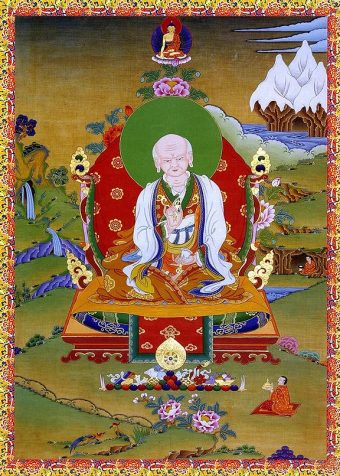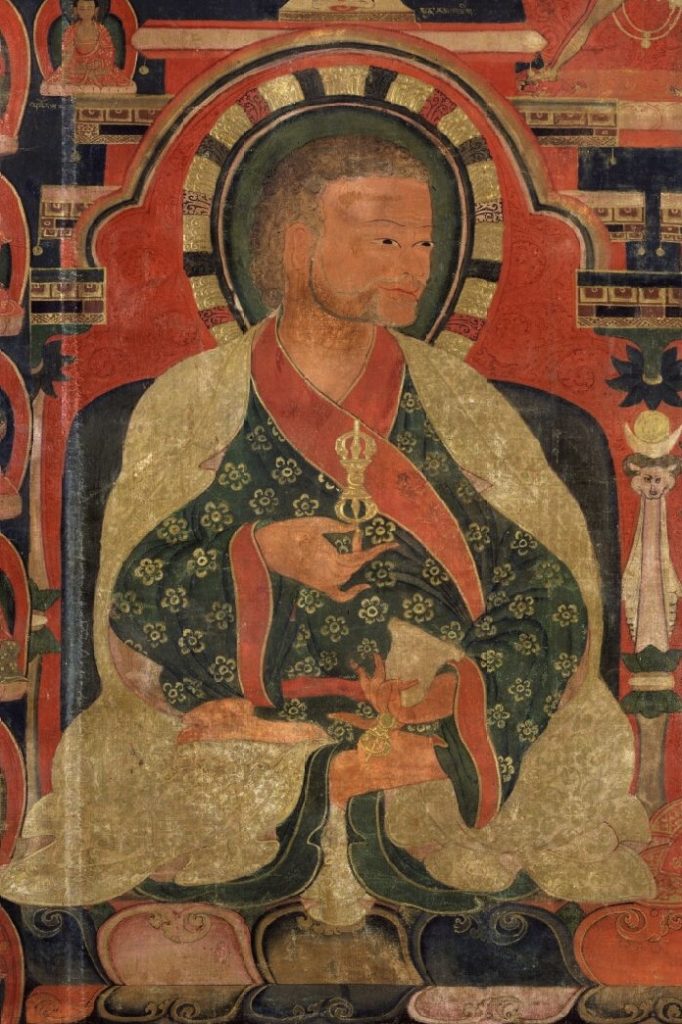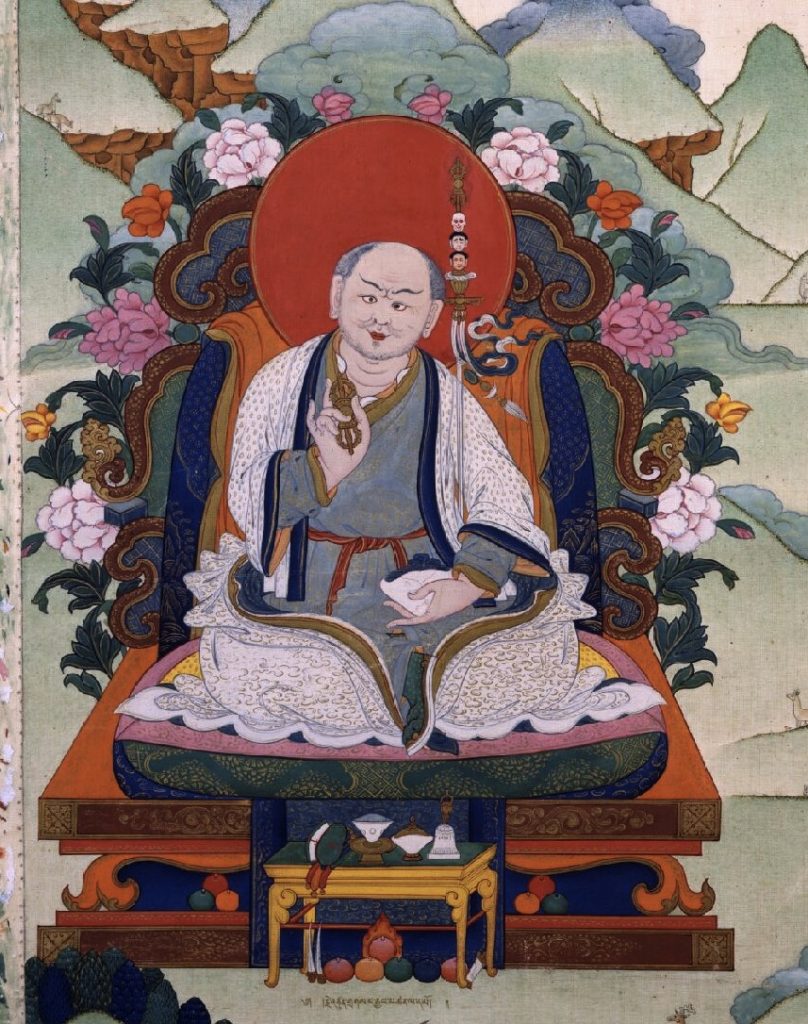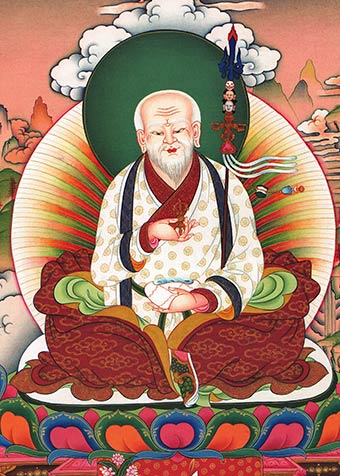Jetsün Dragpa Gyaltsen རྗེ་བཙུན་གྲགས་པ་རྒྱལ་མཚན, the third of the five Sakya Patriarchs, was born in the year of the Female Fire Rabbit (1147) in Sakya, Tibet. His father was Sachen Kunga Nyingpo, the first Sakya patriarch. His mother’s name was Machig Odron. His older brother was Loppon Sönam Tsemo, who was the second Sakya patriarch.
When Jetsün Dragpa Gyaltsen entered the womb, his mother had a very special dream in which a nāga king approached her and requested accommodation. Many auspicious omens accompanied his birth. As an infant, even when barely able to talk, he delighted in staying in isolated places and in studying. He was not attached to mundane concerns such as food and clothing. Although still young, he was completely beyond childish things.
Jetsün Dragpa Gyaltsen received the Upāsaka[1] vows when he was eight years old from his teacher Dawa Gyaltsen, and since then he maintained the vow with great care; he even maintained the vow purer than a typical bhikṣu. Most of his close disciples were monks and he encouraged strict observance of their monastic vows. He was recorded to have personally served all the Sakya monks tea during bimonthly ceremony to purify monastic vows. This indicates his reverence for the monastic robes. He also abstained from meat and alcohol except during special ritual occasio
His father, Sachen Kunga Nyingpo was his first teacher. He was given intensive instructions including Chandragomin’s Twenty Verses on the Bodhisattva Vows, the Hevajra sadhana, and other teachings from the age of eight to twelve. He began teaching these at the age of eleven. At twelve, after his father passed away, Dragpa Gyaltsen taught the Hevajra root tantra to the entire assembly at Sakya. His brother Sönam Tsemo was also an important early teacher of his.
When he was just thirteen, his elder brother Sönam Tsemo left Sakya to pursue his philosophical education at a monastery in Ü-Tsang. Dragpa Gyaltsen was left to take on the responsibilities as effective head of the monastery although he did not formally assume the throne until he was twenty-six. Since then until the age of 70, Jetsun Dragpa Gyaltsen was responsible for the Vajrayāna teachings at the Sakya Monastery. However, his guru had forbidden him to teach the Lam Dre for nine more years so he can have more time to receive the instruction himself.. In actuality thirteen years actually passed before he gave Lam Dre. During that period, he received many teachings from various teachers, and also continued to give other teachings.

Jetsün Dragpa Gyaltsen was constantly engaged in meditation, reading of texts or spreading the Dharma. He also maintained seventy tantric practices every single day without interruption. Furthermore, he devoted his entire life to teaching, and his explanations were easy for disciples to understand. He explained even difficult topics simply and clearly.
Jetsün Dragpa Gyaltsen was a very prolific writer and wrote many original works. His works include the Supplication to the Lam Dre Lineage Lamas; a commentary on the Hevajra Root Tantra; Holy Biography of Sachen Kunga Nyingpo; Verses from the Holy Biography of Sönam Tsemo; Six-Limbed Hevajra Sādhana; Commentary on the 50 types of Guru Devotion; Explanation of the Vajrayāna Root Downfalls; Brief Vajrayoginī Practices; Vairocana Ritual Text and Commentary; Text for Reciting the Mañjuśrī-Nāma-Saṃgīti; Short Explanation and Notes on How to Receive the Twenty-One Taras and the Four-Maṇḍala Green Tara Ritual Text, and so on. In addition, Jetsün Dragpa Gyaltsen was also skilled in sacred drawings, such as various protection chakras, maṇḍalas, and others.
It was mentioned in Jetsün Dragpa Gyaltsen’s biography that he recounted many significant dreams that he had about his previous lives and his future reincarnation. It was also recorded that Jetsün Dragpa Gyaltsen correctly predicted that his nephew Sakya Paṇḍita[2],the fourth Sakya Partriach would play an important role in the Tibetan-Mongolian relations. Many amazing stories describe Jetsün Dragpa Gyaltsen’s spiritual power. One of them involving Jetsün Dragpa Gyaltsen and the Kashmiri Paṇḍita Shakyashri Bhadra, which describe Jetsün Dragpa Gyaltsen’s ability to suspend his ritual instruments in mid-air.
Once when Jetsün Dragpa Gyaltsen was doing retreat at Zimchel Karpo, Shakyashri Bhadra requested to have an audience with Dragpa Gyaltsen. Sakya Paṇḍita, Dragpa Gyaltsen’s nephew led the visitor to his uncle’s retreat hut. When the two appeared at the door, Dragpa Gyalsen had just completed the Guhyasamāja creation stage, and was about to make homage and offering to the deity. Noticing his guest at the door, Dragpa Gyaltsen instantly wanted to rise from his seat to pay homage to Shakyashri Bhadra, hastily he placed his vajra and bell in mid-air, and these objects remained in the air without falling.
Shakyashri Bhadra immediately complimented Dragpa Gyaltsen, “This indicates you have remarkable attainment.” Yet, Dragpa Gyaltsen humbly replied, “I did not mean to show before an expert” and promptly paid homage to Shakyashri Bhadra.
The visitor in return paid homage to Dragpa Gyaltsen too. Shakyashri Bhadra’s entourage—a group of young paṇḍitas saw this scene and were extremely unhappy. Earlier, they requested their teacher not to pay homage to Dragpa Gyaltsen, because Dragpa Gyaltsen was just an Upāsaka, whilst their teacher was holding pure bhikṣu vow.
These young paṇḍitas asked Shakyashri Bhadra’s reason for not keeping his promise, Shakyashri Bhadra told them, “Although we had an agreement, Dragapa Gyaltsen is the real Vajradhara. He was actually completely abiding on the Guhyasamāja maṇḍala when we visited!”

When Dragpa Gyaltsen was 68, many celestial beings came to invite him to pure realms, but he ignored and declined their invitation. The following year, many deities appeared to talk about the merit of Buddhas’ realms, especially the Buddha Amitābha’s realm—Sukhāvatī and invited to come along. He replied, “For me, the pure realms are not particularly enjoyable, whilst the impure realms are not particularly unenjoyable either. However, to purify the external environment and this realm, it is more exalted to live in an impure realm. As there are still countless sentient beings need me here, I will not go to a pure realm just now.”
At the age of 70, the deities appeared saying, “This time, you really must come to the pure realm.” Hearing this, in his pure vision, he also perceived the scene of the pure realm of Sukhāvatī. At the same time, many auspicious signs appeared, such as earth tremors, celestial music and the sky was full of bright light rays. Others including Sakya Paṇḍita also perceived that the deities had come to invite Jetsün Dragpa Gyaltsen to the pure realms.
The next morning, as Dragpa Gyaltsen sat in meditation position and recited supplication prayers, he meditated briefly. In his pure perception, he perceived all of the space filled with countless deities who had prepared a precious throne filled with precious jewels and infinite offerings arranged in space, inviting him to depart for the pure realms. This time, Dragpa Gyaltsen remained silent and gave no reply, by which the deities saw that he was willing to depart for Sukhāvatī.
They pointed at the sky saying, “Behold the design of Skhavati!”
Dragpa Gyaltsen saw the ground entirely made of lapis lazuli, with jeweled trees and countless other ornaments. When he completed his meditation, he described that he saw many auspicious signs, albeit he had forgotten the details.

Earlier, Dragpa Gyaltsen had prophesized that he would depart for the realm of Golden Light. Yet,why was he now invited to head to the pure realm of Sukhāvatī? This is because he made the aspiration, “May I take rebirth in the presence of Sachen Kunga Nyinpo and Loppon Sönam Tsemo.”
So through the power of this aspiration, for a short while, he took rebirth in Sukhāvatī.
Then, preceded by the seven-fold prayer, he meditated on the maṇḍala of the deities, after which he told Sakya Paṇḍita, “First I will depart for Sukhāvatī, the pure realm of Amitābha. There, after a little while, I will depart for the pure realm of Golden Light, where in the form of a universal emperor, I will purify my Buddha realm. After that, on the basis of my third body, I aspire to achieve the excellent attainment of Mahāmudrā.” Saying thus, he entered single pointed concentration on profound Mantrayāna practice.
In the year of the Male Fire Mouse (1216), on the twelfth day of the second lunar month, he departed for Sukavati. Despite the great wealth that passed through his hands as the Sakya throne holder, his biographers claim that he did not accumulate material wealth and when he passed away he possessed only his robe and meditation cushion.
[1]: Upāsaka is referred as a male lay practitioner, or ‘pursuer of virtue’, who has taken refuge and practicing the Dharma at home. Strictly speaking, Upāsaka is male Buddhist, who has generated Bodhicitta (details about Upāsaka can be found in “The Sutra of an Upāsaka’s Precepts”).
[2]: Paṇḍita (Sanskrit), means scholar.

